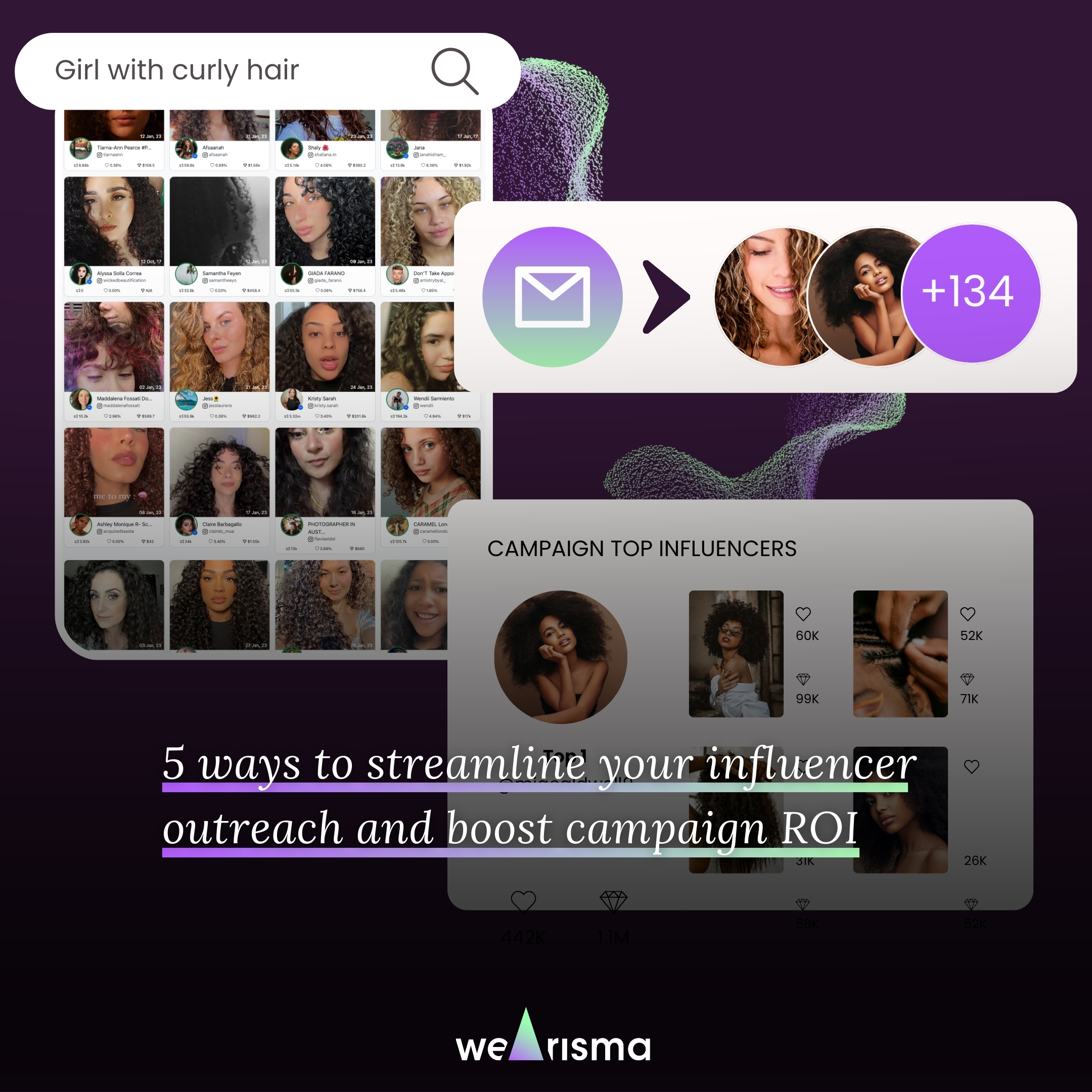🎉 WeArisma joins forces with NielsenIQ (NIQ) to, for the first time ever, measure the impact of Creator Marketing on sales.
Learn to measure social media influencers’ true ROI across the entire customer journey more efficiently using advanced attribution and AI analytics.
Published On: March 19, 2025
Most brands or businesses measure influencer marketing using metrics like follower counts and basic engagement rates. Here’s a simpler way to track influencers’ real impact, from first exposure to purchase and lasting loyalty. In this social media tracking guide, we’ll also cover why old methods don’t tell the whole story and how you can better connect influencer efforts to your bottom line.
The days of treating social media influencers as mere awareness-generating machines are over. In 2025, sophisticated brands recognize that influencer partnerships represent a comprehensive commercial strategy that affects every stage of the customer journey.
Yet despite influencer marketing becoming a multi-billion dollar industry, many marketers still struggle to connect influencer activity to tangible business outcomes.
This guide unveils how forward-thinking brands are mapping and measuring the complete influencer journey – from initial content exposure through to final conversion and beyond – using advanced attribution methodologies and AI-powered analytics.
For too long, brands have evaluated influencer partnerships using superficial metrics like follower counts that say nothing about audience quality, engagement rates that rarely translate to business impact, impressions that fail to capture downstream conversion effects, and sentiment scores without connection to purchase behavior.
These vanity metrics create a blind spot in your influencer marketing strategy. Research shows that influential voices have reached up to 26 times more consumers and generated up to 19 times higher Earned Media Value (EMV)* compared to brand-owned channels. Yet, without proper attribution, this impact often goes uncredited.
Tip: Book a 30-minute WeArisma demo to uncover your brand’s hidden impact.
To accurately map influencer contributions and add tangible value to your social media tracking efforts, developing a comprehensive framework that spans the complete customer journey is essential.
Here are the five essentials stages you should focus on:
Initial content exposure through influencer feeds creates first impressions that may not immediately translate to measurable actions. During this stage, consumers encounter your brand through algorithmic amplification and social sharing. These touchpoints form critical first impressions, even if they don’t generate immediate engagement.
What to track: Social listening for brand mentions, audience growth patterns, and share of voice compared to competitors.
After discovery, consumers often take investigative steps before making decisions. They save content for future reference, visit brand profiles after influencer exposure, and conduct search queries about products or services. These actions signal growing interest but precede any purchase intent.
What to track: Website referral traffic from social platforms, branded search volume increases following campaigns, and social profile growth patterns.
As interest grows, consumers show clear signs of purchase intent. They visit websites from influencer referrals, spend time viewing product pages, and interact with shopping features like wishlists or carts. These behaviors indicate serious purchase consideration.
What to track: Product page views from influencer traffic, wishlist additions, and shopping cart interactions that originate from influencer content.
The actual purchase represents just one point in a longer journey. This includes direct purchases through influencer links, in-store purchases influenced by digital content, and delayed conversions that happen weeks after initial exposure.
What to track: Direct attribution through tracking links, discount code usage, and post-purchase surveys that identify influencer touchpoints in the decision process.
The journey continues long after purchase as customers potentially become repeat buyers and advocates themselves. Former audience members may create their own content featuring your products and drive word-of-mouth recommendations.
What to track: Retention rates of influencer-acquired customers, customer lifetime value compared to other acquisition channels, and user-generated content (UCG) volume following influencer campaigns.
What should you use to uncover more insights in less time when it comes to your influencer marketing tracking and social media attribution activities?
Modern influencer marketing measurement tools now make comprehensive tracking possible through multi-platform analytics that follow how consumers move between platforms during the decision process. For instance, someone might discover your product on TikTok, research it on Instagram, and purchase through your website.
Your customers don’t buy after just one post. Modern influencer marketing tracking tools now show every step that led to a conversion or sale, so you can prove which influencers really drive results. Advanced systems now assign appropriate credit to influencer content throughout the customer journey, accounting for both immediate impacts and extended influence.
Many consumers research products for weeks before purchasing, making extended tracking windows (60 to 90 days) essential to capture delayed impacts that standard seven-day attribution windows miss completely.
FYI: WeArisma’s industry-first AI visual and video recognition technology can surface all the organic content about your brand – even when it’s not tagged or mentioned.
Our AI Organic Measurement tool opens up a whole new universe of impact, empowering brands like yours to demonstrate their true impact and get more budget for future campaigns
The true value of social media influencers isn’t captured in engagement metrics – it’s revealed in the complete journey from awareness to loyalty. Brands that track only surface metrics miss the deeper story of how influencer content transforms curious audiences into loyal customers.
To implement comprehensive influencer marketing tracking for your business or agency, start by documenting your current performance to set clear baseline metrics. You can do this by:
All of these activities combined will help to paint an informative “before” picture for comparison.
Next, implement proper testing methods by using unique tracking parameters for influencer campaigns, creating campaign-specific landing pages, and running tests with control groups where possible. This creates a structured experimental approach rather than relying on assumptions.
Strong attribution requires connecting multiple data sources by combining social platform insights with website analytics, linking customer service data with marketing metrics, and connecting sales data to influencer attribution. This type of holistic view can reveal connections that siloed data usually misses.
Look beyond primary metrics to track secondary effects like changes in search volume for your products, shifts in customer demographics, and effects on customer retention. These indicators often reveal deeper impact than surface-level engagement metrics.
Finally, track both immediate engagement (24 to 48 hours), medium-term conversion (seven to 30 days), and long-term value creation (60-90+ days) to capture the complete timeline of influencer impact.
Even with advanced tools, several challenges remain in comprehensive influencer tracking:
Better measurement should drive better decisions in four key areas:
1. Choose influencers based on true conversion impact rather than follower counts alone. Data often reveals that micro-influencers with highly engaged audiences drive better results than celebrities with passive followings.
2. Create content or influencer briefs that focus on proven conversion drivers. When you know which content types actually motivate purchases, you can guide creators toward these formats rather than chasing engagement alone.
3. Allocate budgets based on full-funnel impact, not just awareness metrics. This often means shifting investment from high-visibility but low-converting partnerships to less flashy but more effective collaborations.
4. Optimize posting schedules and platforms based on consumer journey patterns. Your data may reveal that certain platforms excel at different funnel stages, allowing you to create more strategic cross-platform campaigns.
Read: ‘Is This Good?’: Your Definitive Guide To Product Seeding in 3 Easy Steps
Looking ahead, several trends will reshape how we track influencer impact:
The era of measuring influencer marketing through likes and comments alone is ending. In 2025, brands that thrive treat influencer partnerships as a fully measured, attributable marketing channel with clear impact throughout the customer journey.
By mapping the complete path from first exposure to loyal customer, you’ll unlock the true value of your social media influencers and finally answer the question that matters most: “How do influencers actually drive business results?”
Looking to transform your influencer measurement approach? Discover more about our AI-driven solutions to learn how our platform can help you track and optimize your complete influencer journey.
Creative agencies and SMBs can measure influencer ROI by tracking the whole customer journey, not just likes or impressions. Start with UTM tracking links, branded search spikes, and referral traffic from influencer posts. Then connect these essential data points to conversions, discount code use, and repeat purchases. Using an AI analytics platform like WeArisma can help to automate the process and attribute sales accurately across multiple touchpoints more efficiently.
Influencer marketing impact usually follows five key stages:
Tracking each stage of the journey will help you connect influencer efforts directly to sales and retention outcomes.
Engagement metrics like likes, comments, and shares only reveal surface-level interest. They don’t show whether followers actually buy, subscribe, or recommend your brand. True ROI comes from measuring behavioral signals, like clicks, web visits, conversions, and repeat purchases. Doing so will give you an objective view of how influencer content drives tangible results, not visibility alone.
Agencies can use multi-touch attribution and AI-powered analytics tools to follow customer journeys across platforms like TikTok, Instagram, and YouTube. These systems recognize when someone discovers a product on one platform and purchases it later on another. WeArisma’s AI visual and video recognition adds another layer by uncovering organic influencer mentions even when your brand isn’t tagged.
Access timely cultural trends, strategic creator guidance, and industry best practices.
Discover the most groundbreaking entertainment marketing insights from our eye-opening panel discussion at ‘The State of Influence 2025 and future-proof your brand for tomorrow’s creator economy.
Media Value drives visibility, but cultural heat drives desire.


Join our community and get cultural insights, creator strategy guides, and real-world best practices.